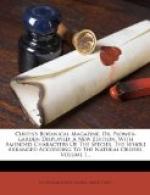We have found the Nurserymen very apt to mistake it for the botryoides, a figure of which it is our intention to give in some future number.
[123]
ANEMONE HORTENSIS. STAR ANEMONE, or BROAD-LEAV’D
GARDEN
ANEMONE.
Class and Order.
POLYANDRIA POLYGYNIA.
Generic Character.
Cal. 0. Petala 5-9. Semina plura.
Specific Character and Synonyms.
ANEMONE hortensis foliis digitalis, feminibus
lanatis. Linn. Syst.
Vegetab. ed Murr.
p. 510. Ait. Hort. Kew. vol. 2. p.
256.
ANEMONE Geranii rotundo folio, purpurascens. Bauh. Pin. 173.
ANEMONE prima. Dodon. Pempt. 434.
ANEMONE latifolia purpurea stellata sive papaveracea.
The purple
Star-Anemone or
Windflower. Park. Parad. p. 204.
[Illustration: No 123]
We are more and more convinced, that in our eagerness, for novelties, we daily lose plants by far more ornamental than the new ones we introduce; the present, a most charming spring plant, with which the Gardens abounded in the time of PARKINSON, is now a great rarity; its blossoms, which are uncommonly brilliant, come forth in April, and, like those of many other plants, appear to advantage only when the sun shines.
It may be propagated either by seeds, or by parting its roots in Autumn, in the former way we may obtain many beautiful varieties.
It prefers a light loamy soil and moderately exposed situation.
Roots of a variety of this plant with scarlet double flowers are imported from Holland, under the name, of Anemonoides, and sold at a high price.
[124]
IBERIS GIBRALTARICA. GIBRALTAR CANDY-TUFT.
Class and Order.
TETRADYNAMIA SILICULOSA.
Generic Character.
Corolla irregularis: Petalis 2 exterioribus majoribus. Silicula polysperma, emarginata.
Specific Character and Synonyms.
IBERIS Gibraltarica frutescens foliis apice
dentatis. Linn. Syst.
Veg. ed. 14.
Murr. p. 589.
THLASPIDIUM Hispanicum, ampliore flore folio crasso
dentato. Dill.
Elth. 382. t.
287. f. 37.
[Illustration: No 124]
The flowers of this plant, a native of Gibraltar, bear some resemblance to those of the Common Candy-Tuft, but when they blow in perfection, they are usually twice as large; hence they are highly ornamental in the green-house, which early in the Spring, the time of their coming forth, stands in need of some such shewy flowers.




